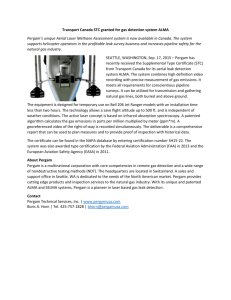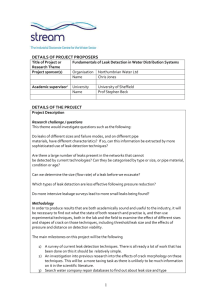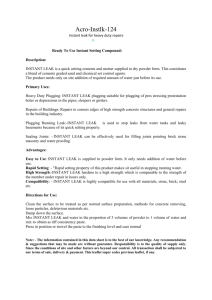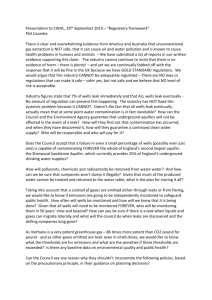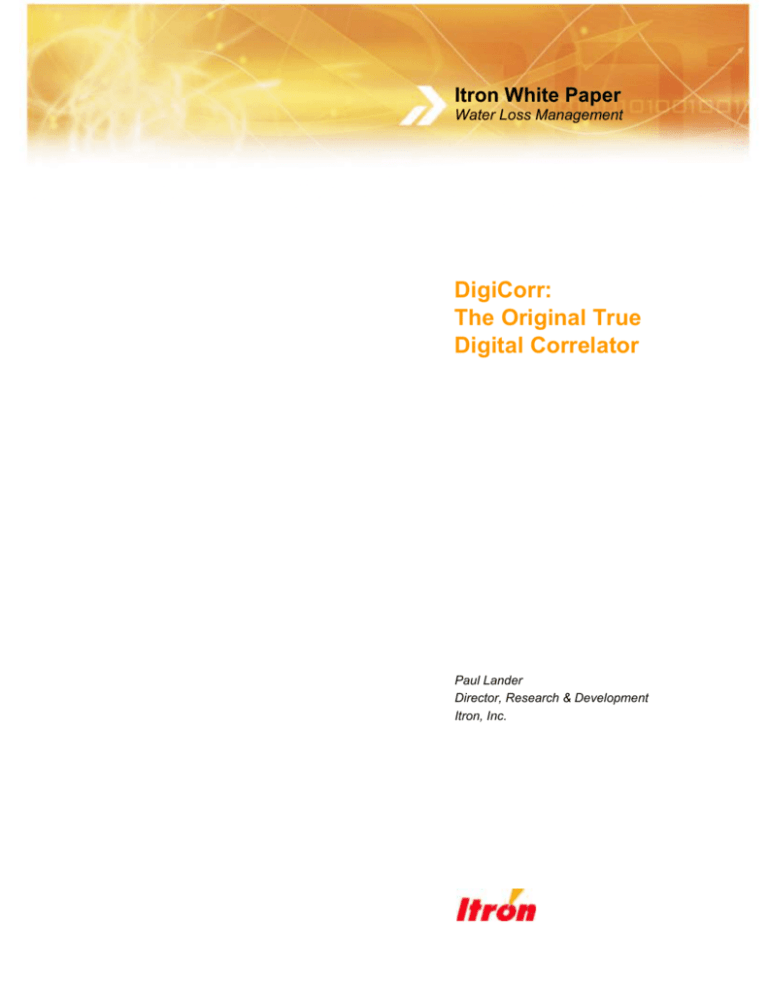
Itron White Paper
Water Loss Management
DigiCorr:
The Original True
Digital Correlator
Paul Lander
Director, Research & Development
Itron, Inc.
Introduction
Water demand is now doubling every 20 years and it is predicted that approximately 60 percent of the world’s population will be
short of water by 2025. With losses from water distribution systems varying from 10 to 60 percent (dependant upon geography,
measurement method and politics), it is widely recognized that these losses are not sustainable. This paper identifies the
important role of the leak noise correlator for modern leak location in water pipes. It sets out the major innovations and
advantages of DigiCorr, compared to the older technologies in other leak noise correlators.
History of Correlation
The first leak noise correlator was developed in Europe and introduced in the late 1970s. It is shown in Figure 1 together with a
low-cost analog correlator from the 1990s.
This correlator was able to find leaks but was very large, had limited
range, and needed cables for sensor connection. The early 1980s saw
the introduction of radio systems which gave easier deployment and
faster leak location. The leak signal was continuously amplified and
filtered, and its resolution was reduced for transmission as an FM
analog radio signal. The signal degraded with range and was
transmitted with as much radio power as permitted. Today the FCC
limits radio-frequency power in many frequency bands. This approach
is essentially unchanged today in analog correlators.
Figure 1. Leak Noise Correlator circa 1979.
History of Digital Correlation
The first digital correlator, DigiCorr, was developed by Flow Metrix (now Itron) in 1997. The unique elements of DigiCorr are:
Complete Digital Signal Path from Sensor to process CD quality sound directly from the sensor
Digital Data Radio Communication with a 1-MHz bandwidth to transmit this CD quality sound to the correlation
processor.
Intelligent Field Sensor Units (FSUs) in constant two-way communication with the correlation processor. The FSUs
record vibrations optimally according to the pipe and environmental conditions.
Advanced digital signal processing capabilities to pinpoint leak sounds that conventional correlators are unable to hear or
distinguish from ambient noise or pipe vibrations.
DigiCorr III is the latest evolution of DigiCorr. Innovations include:
Automatic Leak Frequency Analysis (ALFA) characterizes and uses the specific time-frequency signature of leak sound to
improve pinpointing precision and aid identification of multiple leaks.
Delayed Recording Mode means that operation is unlimited by radio range restrictions or access to pipes.
Digital Mapping and Database Tools for detailed analysis of an unlimited number of recordings and creation of an audit
trail.
© 2007, Itron Inc. All rights reserved.
2
Aren’t All Correlators Digital?
All leak noise correlators since the late 1970s have used digital logic for correlation processing. Several patented processes
together make DigiCorr innovative:
Digitization of the recorded leak noise as soon as electrically advantageous after the sensor
and with the highest attainable resolution.
Transmission with CD sound quality through the digital radio system to the correlation
processing stage, providing a high resolution leak signal which can be pinpointed where
conventional correlators sometimes fail.
Advanced PC-based digital signal processing to analyze data more effectively than older,
expensive microprocessor-based units.
Figure 2. The DigiCorr III Field Sensor Unit (FSU) with intelligent processing and two-way
digital radio communication.
Leak Noise Resolution
The idea of a “digital data path” has been uniquely introduced in the DigiCorr. This digital data path is at the core of the patented
DigiCorr architecture1. The sensor, a micro-machined accelerometer, is a purely analog device which transduces the analog pipe
vibration into an analog charge. An ultra low-noise charge amplifier converts the flow of charge to a signal voltage suitable for
digitizing. The sensor is hermetically sealed in a stainless steel vessel designed to isolate this circuitry from the environment
physically, electrically and magnetically. Alternatively, a hydrophone sensor can be used, where suitable fittings allow, providing
direct detection of the acoustic energy from the water. A low-noise, electrically shielded cable brings power into the sensor from
the FSU and conveys the signal voltage to the digitizer at a necessary distance within the FSU.
Why Not Digitize in the Sensor?
To preserve the fidelity of the signal voltage, it is important to isolate sources of interference physically from the sensor and
charge amplifier. The inevitable interference sources encountered include:
Noise from the digital power supplies needed for the digitizer and processor. This noise is kept physically remote from
the sensor by the cable. The low-noise cable appears ‘invisible’ to the digitizer because the impedance of the cable is
many millions of times lower than the input impedance of the digitizer.
Electromagnetic (’60-Hz’) interference from power lines. This interference is removed digitally in the PC software,
eliminating the need for leak signal distorting electronic filters.
Interference caused by movement of the cable, due to wind or environmental vibrations. This low-frequency interference
is picked up by the sensor in all correlators. When transmitted it can significantly limit the resolution of the leak noise. It
is removed in DigiCorr by software digital signal processing, both in the FSU and the PC software. Artifact due to the
‘tribo-electric effect’ (caused by vibration of the charge amplifier itself) is avoided altogether in DigiCorr by selection of
materials.
1
US Patent No. 5,974,862, Lander et al., “Method for detecting leaks in pipelines”. Patent pending in other territories.
© 2007, Itron Inc. All rights reserved.
3
The Intelligent Digital FSU
Once the signal voltage reaches the FSU, it is immediately digitized without any filtering. The variations in amplitude of the
acoustic signal depend upon the noise in the pipe, particularly the low-frequency components. This range is very wide (on the
order of 1:10,000). Conventional correlators can transmit a signal range of the order of only 1:100 and therefore must
significantly reduce the resolution of the leak noise. DigiCorr uses software-programmable gain and a 16-bit Analog to Digital
Converter (ADC), achieving a useful signal range of over 1:500,000. DigiCorr is therefore able to capture the signal from the
pipe at any level and to convert it to a digital representation with better than CD quality.
DigiCorr’s digital data radios are inherently two-way devices, putting the FSUs in constant communication with the correlation
processor (PC software). This permits the correlation processor to:
Manage power in the FSUs remotely
Program the FSU with the recording parameters that best suit the environment (large-diameter or plastic pipes, long
range, etc.)
Implement unique features, such as remote access and delayed recording, under user control
Unlike conventional correlators, DigiCorr can optimize its recording protocol (sampling rate, data resolution, transmission
coding, and other parameters) in every recording. The recording protocol is set transparently to the user, in response to commands
from the PC software and digital processing performed in the FSU.
Digital Data Radio Communication
DigiCorr uses sophisticated frequency-hopping, spread-spectrum (FHSS) digital radios, which operate at 2.4GHz. These radios
are sometimes called “software” radios because of their ability to transmit large amounts of digital data intelligently.
Conventional Frequency Modulated (FM) radios transmit an analog representation of the vibration sensed from the pipe. The
sound quality deteriorates with distance transmitted and is typically poor (analogous to a 78-rpm record) upon reception at the
base station. If another transmitter is present at the same frequency, then the transmission will be blocked (jammed). FM radios in
leak noise correlators typically transmit at 433–470 MHz, with an available bandwidth of 25 kHz (or 10 kbps) and require
product approval in most parts of the world.
In contrast, FHSS digital radios utilize a bandwidth of 1 MHz (or typically 256 kbps). This makes it possible for DigiCorr to
transmit high resolution vibrations sensed from the pipe. The transmission is a true digital signal (approximately equal to or better
than CD quality). Within certain power and antenna limits, DigiCorr can be programmed for license-free use worldwide.
If another transmitter is present, frequency hopping radios will automatically switch to another frequency channel to avoid
jamming. This feature is becoming particularly important with the proliferation of wireless devices. If the radio-frequency
environment is noisy (poor reception, other transmitters, etc.), DigiCorr will automatically retransmit any data from the FSUs that
was not received by the base station.
Automatic Leak Frequency Analysis (ALFA)
DigiCorr has introduced a powerful new software tool—ALFA. Conventional leak noise correlators are limited by:
Their need for manual selection of discrete filters at the base station
Disturbance of the correlation from flow noise, usage, traffic and other environmental noise
Loss of the leak noise correlation due to limited recording resolution
© 2007, Itron Inc. All rights reserved.
4
The need for discrete filters has significantly limited the usefulness of conventional leak noise correlators. A skilled operator must
sometimes experiment with a selection of filters either to detect a leak or to pinpoint the leak accurately. Occasionally a leak is
missed (does not correlate) because no single (parametric) linear bandpass filter is able to isolate a coherent leak sound at both
sensors. This process can be time-consuming for the user and requires their attention after each recording. Multiple leaks present
in one recording can be missed.
How ALFA Works
DigiCorr uses ALFA to detect and pinpoint leak sounds with no user intervention. ALFA is a digital signal process capable of
isolating (multiple) leak sounds individually at each sensor and statistically optimizing their correlation at each possible value of
time delay. It can be thought of as constantly scanning the data arriving at each sensor, looking for energy that is coherent in time
and frequency between the two sensors. Unlike conventional filters, ALFA is able to extract leak sounds from the recording even
when much greater noise may be present at the same frequencies. It is able to collect leak sound energy from many different
frequencies—not just a single frequency band—and to discriminate among multiple sources of leak sounds. ALFA tracks the
spectral patterns of leak sound over time to “tune in” to the leak sound even when other noise dominates the recording. Once
ALFA has registered the characteristics of the leak sound, the results of the correlation process will be significantly less
susceptible to disruption by ambient noise, such as traffic, or changing flow noise due to usage variations. A key aspect of ALFA
is that this tracking and characterization of leak sounds is performed uniquely and optimized in every recording.
The Benefits of ALFA
With ALFA an accurate registration and pinpointing of each leak sound occurs automatically with every recording. This includes
multiple leak sounds within a correlation span and leak sounds that would have been lost in analog FM radio transmission. When
no leak is present, no correlation occurs. It is not necessary to re-record with many different filter settings to ensure that ‘no leak’
is truly present.
Figure 4. Comparison of correlation with and without ALFA processing.
The benefit of ALFA is shown in Figure 4. The screen above and left depicts the digital correlation result over 869
feet of 4” diameter cast iron pipe. No correlation peak is observed. The screen on the right shows exactly the same
leak noise data file but processed using ALFA filtering. A correlation peak indicates a leak at 91 feet from the red
sensor.
© 2007, Itron Inc. All rights reserved.
5
Leakage Management Tools
ALFA enables the software tools for leakage management that are available in DigiCorr Pro. Because ALFA works transparently,
it is possible to make recordings from many sites, analyze that data and pinpoint the leak in the field, and also automatically store
that data.
DigiCorr is the first correlator that can be used for network-wide surveying and analysis:
A single 60-second recording is analyzed, saved, and any leak(s) present are pinpointed without user intervention.
An unlimited number of recordings can be archived in a built-in database.
Any recording can be retrieved for subsequent analysis or review by searching for text addresses, map locations, dates,
etc.
The DigiCorr database can be read by popular database, spreadsheet, and statistics software programs to analyze leakage
by zone, pipe material, pipe size, dates, etc.
The DigiCorr database can be flexibly extended by the user by adding fields for pipe age, pressure zone, etc.
DigiCorr Results
Figure 5. Correlation result with sensors nearly a mile apart (4,643 feet) on a 24” cast iron trunk main.
Figure 6. Pinpointed leak on polyethylene (MDPE) pipe over a distance of 512 feet.
© 2007, Itron Inc. All rights reserved.
6
Itron Inc.
Itron is a leading technology provider and critical source of knowledge to the global energy and water industries. Nearly 3,000
utilities worldwide rely on Itron technology to deliver the knowledge they require to optimize the delivery and use of energy and
water. Itron delivers value to its clients by providing industry-leading solutions for electricity metering; meter data collection;
energy information management; demand response; load forecasting, analysis and consulting services; distribution system design
and optimization; web-based workforce automation; and enterprise and residential energy management.
To know more, start here: www.itron.com
Itron Inc.
Corporate Headquarters
2111 North Molter Road
Liberty Lake, Washington 99019
U.S.A.
Tel.: 1.800.635.5461
Fax: 1.509.891.3355
www.itron.com
Itron, Inc.
Acoustic Leak Detection
One Clock Tower Place
Suite 100
Maynard, Massachusetts 01754
U.S.A.
Tel.: 1.800.517.4737
Fax: 1.978.897.1292
Due to continuous research, product improvement and enhancements, Itron reserves the right to change product or system specifications without notice. Itron is a registered trademark
of Itron Inc. All other trademarks belong to their respective owners. © 2007, Itron Inc.
Publication 100788WP-01
04/07



